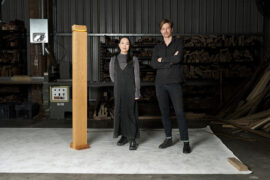As architecture and design becomes more attuned to the value of flexibility, ergonomics have come to the forefront of conversations about design. What does this mean for the ergonomics discipline moving forward?
In the past, ergonomics was a workplace-centric concept that centred upon injury, both in terms of preventing it and providing rehabilitation where necessary. This is reasonable, considering that Safe Work Australia estimates that Australia spends $61.8 billion annually on workplace injury and illness – more than double what it spends on defence. Yet in today’s workplace, where concerns about overall worker wellbeing prevail, a more holistic approach to ergonomics is emerging. The discipline has expanded to not only avoiding and treating injury, but to avoiding and treating discomfort and bad working habits that may only turn into injury further down the track. It has also transcended the workplace and is entering all sectors of design from educational and hospitality spaces to the residential sector.
Though ergonomics today certainly remains concerned with injury prevention and treatment, it is primarily focused on designing objects and environments that are more comfortable and easier to use than their predecessors. Thanks to sweeping changes to national work health and safety legislation with the introduction of the federal Work Health and Safety Act 2011, ergonomics have been brought to national attention. Recognition of the importance of appropriate ergonomic design in minimising injury risks and improving user comfort has seen ergonomic iterations of everything from desk chairs to sofas and computer keyboards.
Crucially, our present-day understanding of ergonomics departs from past iterations of the discipline in its emphasis of flexibility. In the past, ergonomic data was used to design for a specific demographic, with anthropometric data collated and used to generate the ‘ideal user’. As with all averages, this ‘ideal user’ smoothed out the differences between disparate users, pulling them all toward a central tendency: after all, it is easier to design for one person than it is to design for many. But how effective is this design methodology? Designing for a single ‘ideal user’ may be straightforward, but the design world is fast becoming aware of the danger of rigid design that does not cater for those who fall outside the scope of the average.
Today, our understanding of ergonomics is premised on the fact that no two people – not even those from the same demographic or with similar physical characteristics – are exactly alike. Increasingly, ergonomics is moving away from suggesting designing for between the 5th percentile female and the 95th percentile male, and toward designing a flexible solution that adapts to suit everyone. Thus ergonomic design at present makes heavy use of adjustability, allowing users to tweak a product or their environment until it is just right for them. Emphasis is also placed on making the adjustment process itself as smooth and simple as possible: new generations of seats such as those from Humanscale adjust intuitively to user weight and posture, effortlessly adapting to new users without complicated levers or buttons.
The changing nature of ergonomics is affecting the discipline itself, which must now adapt to an increasing and changing set of demands. Formerly a speciality discipline that existed on the peripheries of design, ergonomics’ entry into the mainstream has made it one of the foremost considerations of any design project. As David C. Caple of the International Ergonomics Association writes, the integration of ergonomics into mainstream design marks a new chapter for the profession. The industry must now work to build networks with other stakeholders involved in design and research including universities, governments, and funding agencies.
Ergonomists themselves must also work toward achieving greater multidisciplinary cohesion with the design and broader health sectors. To do this, they must hone strong facilitation and communication skills that allow them to be good communicators and “agents of change” who can mentor professionals from other disciplines and encourage them to incorporate new technologies and strategies. Particularly as ergonomics extends its scope to include gender and race diversity and refines its focus on slips, trips, and falls, the discipline must become part of the everyday community conversation. Community engagement is necessary to understand the different and particular needs of a broad spectrum of end-users and address these in the most appropriate manner.
Though its literal translation from Greek is “work laws”, ergonomic principles and guidelines have been far from law for many years. The growing acceptance of the discipline into the mainstream of design looks poised to change this, however, and presents an exciting opportunity for the industry to continue to grow and adapt.
INDESIGN is on instagram
Follow @indesignlive
A searchable and comprehensive guide for specifying leading products and their suppliers
Keep up to date with the latest and greatest from our industry BFF's!

The undeniable thread connecting Herman Miller and Knoll’s design legacies across the decades now finds its profound physical embodiment at MillerKnoll’s new Design Yard Archives.

For Aidan Mawhinney, the secret ingredient to Living Edge’s success “comes down to people, product and place.” As the brand celebrates a significant 25-year milestone, it’s that commitment to authentic, sustainable design – and the people behind it all – that continues to anchor its legacy.

Jesse Lockhart-Krause, Director of Lockhart-Krause Architects, tells us about a storied building in Queensland that has now become a functional workplace for a therapy centre.

Director Ian Briggs is one of the longest serving members of the Plus team and – with a milestone rebrand complete and a Sydney event just yesterday – he walks us through the state of play at the practice in 2025.

grovve sets a new benchmark in youth mental wellness design – an empathetic, biophilic sanctuary where mental wellbeing is nurtured through choice, comfort and co-creation.

Humanscale’s Chief Sustainability Officer is embarking on a tour of Australia, delivering a talk entitled: “Sustainable by Design: Materials Transparency for a Healthier Planet.” At the same time, the company opens a brand new showroom in Sydney. We met her to find out more.
The internet never sleeps! Here's the stuff you might have missed

Hogg & Lamb’s Albion Bathhouse has been awarded The Health & Wellbeing Space at the INDE.Awards 2025. The project reimagines the contemporary bathhouse as an immersive architectural journey – one that restores balance through atmosphere, materiality and mindful design.

AHEC’s KEEP exhibition at Cult Sydney sees six Australian architects craft lasting furniture pieces, on view until 4th October.